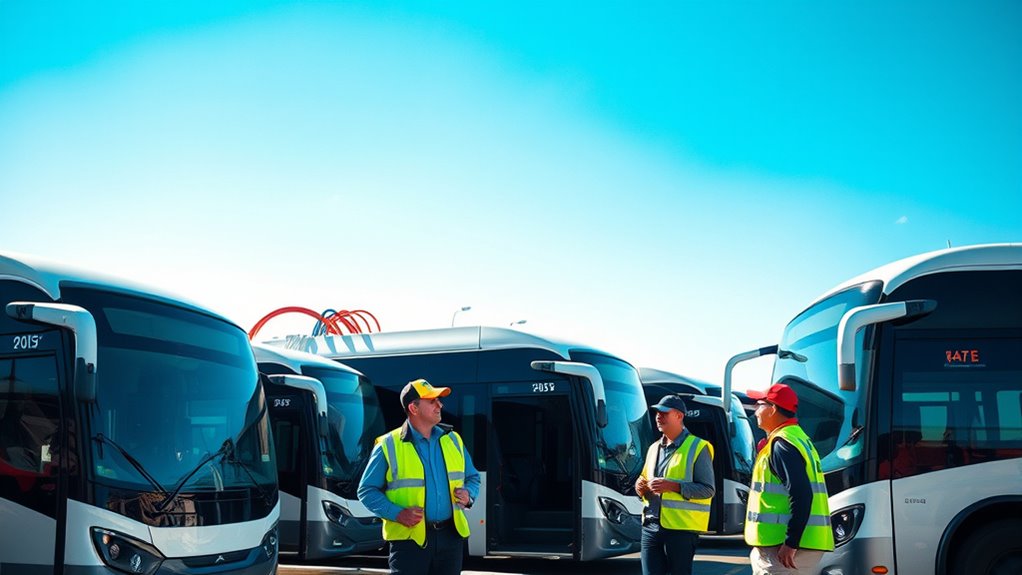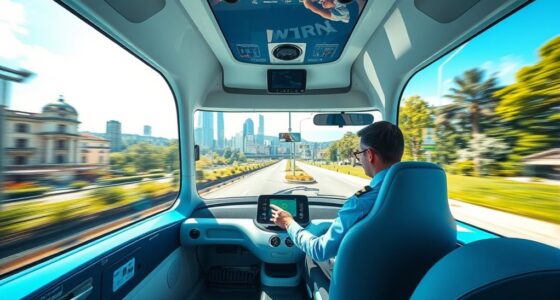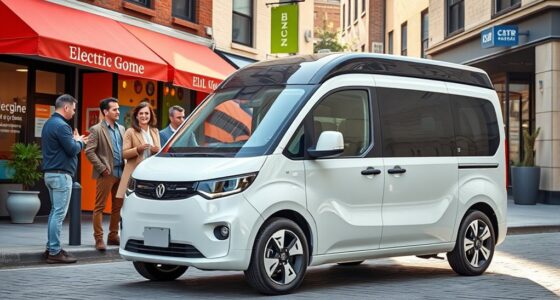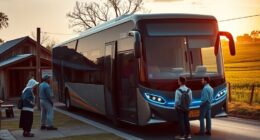Bus operators say switching to electric buses boosts operational efficiency and cuts costs markedly. You’ll notice quieter rides, fewer vibrations, and better environmental impact, which can attract more passengers. They also highlight lower maintenance expenses and the long-term savings from reduced fuel use. Many appreciate the support from government incentives and advancements in battery tech that make the switch more practical. If you’re curious about how these benefits come together, you’ll find useful insights as you continue exploring.
Key Takeaways
- Bus operators highlight reduced operational costs and maintenance as major benefits of electric buses.
- Many report improved passenger experience due to quieter, smoother rides.
- Operators note the positive environmental impact, including lower emissions and better air quality.
- Challenges such as high initial investment and charging infrastructure needs are acknowledged.
- Successful deployments often depend on government incentives and advancements in battery tech.
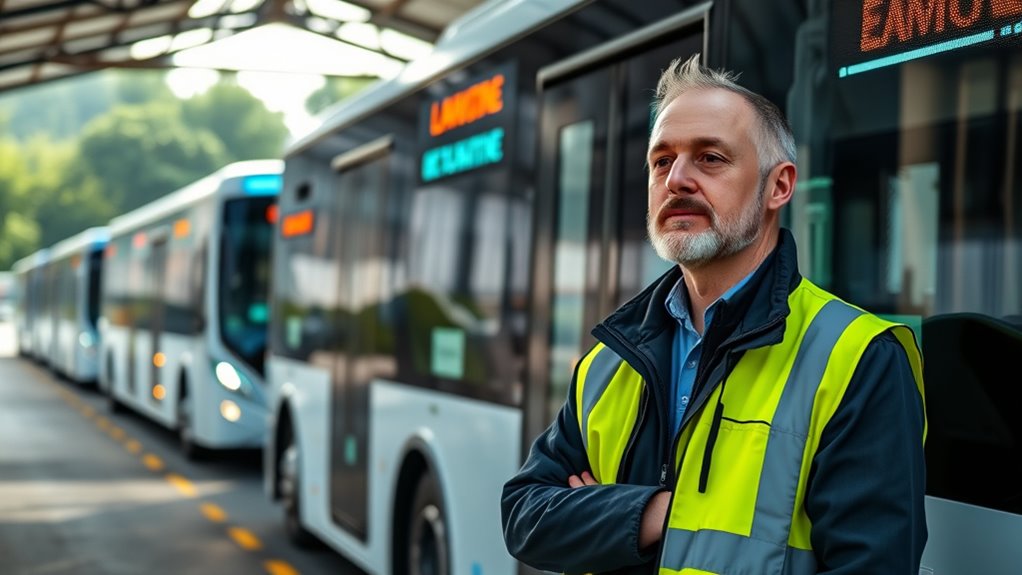
Have you considered how switching to electric buses can transform urban transportation? Many bus operators are discovering the numerous benefits of adopting electric vehicles, which extend beyond just environmental improvements. They highlight that electric buses dramatically cut greenhouse gas emissions, making cities cleaner and healthier. By replacing diesel buses, operators can eliminate pollutants that contribute to smog and ground-level ozone, resulting in better air quality. This shift supports broader climate goals, with potential reductions of over 2 million tons of greenhouse gases annually across the U.S. alone. Such benefits not only help cities meet environmental targets but also demonstrate a commitment to sustainable mobility.
Operators also emphasize the operational advantages of electric buses. They note that electric motors are inherently more efficient, converting around 60% of electrical energy into motion, compared to the less efficient combustion engines. This efficiency translates into lower running costs because electricity is cheaper than fuel, and maintenance expenses decrease due to fewer moving parts and less wear and tear. Many operators report that their electric fleets experience about half the operational costs of traditional diesel buses over time. Additionally, the decreasing costs of battery technology further enhance the cost-effectiveness of electric bus adoption.
Furthermore, features like regenerative braking allow electric buses to recover energy during deceleration, further improving efficiency and reducing energy consumption. Financially, bus operators find that although initial investments are higher, long-term savings outweigh these costs. Reduced fuel expenses combined with lower maintenance bills lead to significant savings, especially in regions where electricity rates are favorable. Many governments offer incentives for electric bus purchases, easing the capital expenditure burden. Moreover, ongoing advancements in battery technology continue to enhance battery performance, making electric buses more practical for diverse urban routes. These improvements are driven by ongoing research and development efforts within the industry.
These financial incentives, along with lower operational costs, make electric buses a cost-effective solution for transit agencies seeking to optimize budgets over their vehicle lifespan. Passenger experience also sees notable improvements. Electric buses operate quietly, creating a more comfortable and less stressful ride for passengers. The smoother ride due to fewer vibrations enhances comfort, while the quieter environment encourages more people to choose public transportation.
This positive perception can boost ridership and support environmental messaging. Operators recognize that electric buses project a modern, eco-friendly image, helping transit agencies appeal to environmentally conscious communities. From a technological standpoint, operators value the continuous advancements in battery technology, which extend range and improve charging speeds. They appreciate the integration of efficient charging systems, including fast-charging options, and the ability to power buses with renewable energy sources like solar or wind.
The use of data analytics optimizes fleet management, and innovative design solutions boost sustainability efforts. Overall, many bus operators see electric buses as a smart, forward-looking choice that aligns with their goals of efficiency, environmental responsibility, and passenger satisfaction.
Frequently Asked Questions
What Training Is Required for Drivers to Operate Electric Buses?
You need thorough training to operate electric buses safely and efficiently. This includes understanding SOC management, charging protocols, diagnostics, and pre-trip inspections tailored for electric powertrains.
You’ll also learn range optimization, thermal management, emergency responses, and cybersecurity measures. The training involves a four-tiered approach, simulation scenarios, and documentation to meet federal standards.
Cross-department coordination and feedback help you adapt to new operational practices and guarantee safety across all functions.
How Do Electric Buses Handle Extreme Weather Conditions?
They say, “A smooth sea never made a skilled sailor,” and the same applies to electric buses in extreme weather. In cold conditions, you’ll notice reduced range and battery efficiency, but with proper thermal management, these buses perform reliably.
You’ll appreciate their better traction, instant torque, and easier maintenance. Shorter routes or midday charging can help, making electric buses a resilient choice even in the harshest climates.
Are There Any Differences in Maintenance Routines for Electric Versus Diesel Buses?
When comparing maintenance routines, you’ll notice electric buses are simpler because they’ve fewer moving parts, requiring less frequent upkeep. You won’t need oil changes or regular replacement of components like filters or brake pads, unlike diesel buses.
Instead, your focus shifts to visual inspections and monitoring battery health. This streamlined approach cuts maintenance costs by up to half and reduces downtime, making electric buses more efficient and cost-effective over time.
What Are the Current Charging Infrastructure Requirements for Electric Buses?
You need to understand that electric bus charging infrastructure requires high-capacity electrical systems, often demanding 10 MW or more for large fleets.
You’ll need fast chargers, like DC fast chargers, or overnight Level 2 chargers, depending on your schedule.
Upgrading utility services is essential, and costs can be substantial.
Proper planning guarantees your infrastructure can handle peak demands, and working with utility providers helps streamline upgrades and avoid disruptions.
How Do Electric Buses Impact Overall Fleet Management and Scheduling?
You’ll find that electric buses improve fleet management and scheduling by enabling real-time tracking and data analytics, which boost efficiency. They allow you to optimize charging schedules, reduce downtime through predictive maintenance, and better allocate resources like chargers and personnel.
With adaptable management systems, you can respond swiftly to changing energy costs and operational demands, making your fleet more reliable, cost-effective, and environmentally friendly.
Conclusion
As you consider switching to electric buses, remember the dawn of a new era, brighter and cleaner like the first light breaking through the darkness. By embracing this change, you’re steering towards a future where the air is clearer and the streets quieter—much like turning the page to a fresh chapter in a story that benefits everyone. Your decision can be the spark that ignites a cleaner, greener journey for generations to come.
